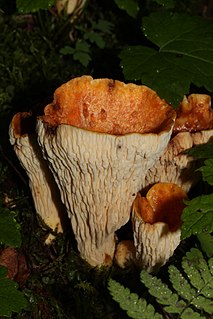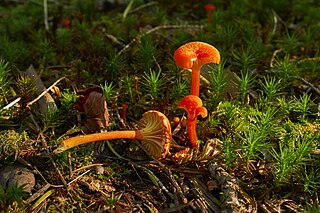
Chanterelle is the common name of several species of fungi in the genera Cantharellus, Craterellus, Gomphus, and Polyozellus. They are among the most popular of wild edible mushrooms. They are orange, yellow or white, meaty and funnel-shaped. On the lower surface, underneath the smooth cap, most species have rounded, forked folds that run almost all the way down the stipe, which tapers down seamlessly from the cap. Many species emit a fruity aroma, reminiscent of apricots, and often have a mildly peppery taste. The name chanterelle originates from the Greek kantharos meaning "tankard" or "cup", a reference to their general shape.

The Cantharellaceae are a family of fungi in the order Cantharellales. The family contains the chanterelles and related species, a group of fungi that superficially resemble agarics but have smooth, wrinkled, or gill-like hymenophores. Species in the family are ectomycorrhizal, forming a mutually beneficial relationship with the roots of trees and other plants. Many of the Cantharellaceae, including the chanterelle, the Pacific golden chanterelle, the horn of plenty, and the trumpet chanterelle, are not only edible, but are collected and marketed internationally on a commercial scale.

Cantharellus is a genus of popular edible mushrooms, commonly known as chanterelles, a name which can also refer to the type species, Cantharellus cibarius. They are mycorrhizal fungi, meaning they form symbiotic associations with plants, making them very difficult to cultivate. Caution must be used when identifying chanterelles for consumption due to lookalikes, such as the jack-o'-lantern mushroom, which can make a person very ill. Despite this, chanterelles are one of the most recognized and harvested groups of edible mushrooms.
Fungal keratitis is a fungal infection of the cornea, which can lead to blindness. It generally presents with a red, painful eye and blurred vision. There is also increased sensitivity to light, and excessive tears or discharge.
Hygrocybe is a genus of agarics in the family Hygrophoraceae. Called waxcaps in English, basidiocarps are often brightly coloured and have dry to waxy caps, white spores, and smooth, ringless stems. In Europe they are characteristic of old, unimproved grasslands which are a declining habitat, making many Hygrocybe species of conservation concern. Four of these waxcap-grassland species, Hygrocybe citrinovirens, H. punicea, H. spadicea, and H. splendidissima, are assessed as globally "vulnerable" on the IUCN Red List of Threatened Species. Elsewhere waxcaps are more typically found in woodlands. Most are ground-dwelling and all are believed to be biotrophs. Around 150 species are recognized worldwide. Fruit bodies of several Hygrocybe species are considered edible and are sometimes offered for sale in local markets.

David Arora is an American mycologist, naturalist, and writer. He is the author of two popular books on mushroom identification, Mushrooms Demystified and All That the Rain Promises and More....

Ganoderma orbiforme – most commonly known as G. boninense or just Ganoderma in oil palm pathology – is a species of polypore fungus that is widespread across southeast Asia. It is a plant pathogen that causes basal stem rot, a disease of the African oil palm. The fungus was first described scientifically in 1838 by Elias Magnus Fries from collections made in Guinea. Leif Ryvarden transferred it to the genus Ganoderma in 2000. In addition to its type locality, the fungus has also been collected from the Bonin Islands in the Pacific, and from Venezuela and Puerto Rico.

Turbinellus floccosus, commonly known as the scaly vase, or sometimes the shaggy, scaly, or woolly chanterelle, is a cantharelloid mushroom of the family Gomphaceae native to Asia and North America. It was known as Gomphus floccosus until 2011, when it was found to be only distantly related to the genus's type species, G. clavatus. It was consequently transferred from Gomphus to Turbinellus. The orange-capped vase- or trumpet-shaped fruiting bodies may reach 30 cm (12 in) high and 30 cm (12 in) wide. The lower surface, the hymenium, is covered in wrinkles and ridges rather than gills or pores, and is pale buff or yellowish to whitish.

Agaricus pattersoniae is an edible species of mushroom. It is found in the United States, where it associates with cypress trees. It has been proposed for inclusion in the IUCN Red List of Threatened Species.

Polyozellus is a fungal genus in the family Thelephoraceae, a grouping of mushrooms known collectively as the leathery earthfans. Previously considered a monotypic genus, it now contains the Polyozellus multiplex species complex. The genus name is derived from the Greek poly meaning many, and oz, meaning branch. It is commonly known as the blue chanterelle, the clustered blue chanterelle, or, in Alaska, the black chanterelle. The distinctive fruit body of this species comprises blue- to purple-colored clusters of vase- or spoon-shaped caps with veiny wrinkles on the undersurface that run down the length of the stem.

Aphroditeola is an agaric fungal genus that produces pink cantharelloid fruit bodies on coniferous forest floors. The lamellae are forked and typically the fruit bodies have a fragrant odor described as candy-like, cinnamony or pink bubble gum-like. In the last century it was classified in Hygrophoropsis, a genus in the Boletales. However, Hygrophoropsis has dextrinoid basidiospores while Aphroditeola lacks these. Phylogenetically Aphroditeola is classified in the Agaricales near the Hygrophoraceae. Little is known about its biology except that the type species can be grown in culture from basidiospores and it produces pinkish to reddish-orange mycelium. In other literature and web sites the type species is called by synonymous names Hygrophoropsis morganii or Hygrophoropsis olida or incorrectly labelled Hygrophoropsis rufescens, a misapplied name.

Hygrocybe cantharellus, commonly known as chanterelle waxy cap, is an agaric in the family Hygrophoraceae. It is found in eastern North America and Australia. The European Hygrocybe lepida was previously referred to this name, but is now known to be distinct.

Cantharellus lewisii is a species of fungus in the family Cantharellaceae.

Cantharellus altipes is a species of fungus in the family Cantharellaceae. Described as new to science in 2011, it is found in Texas, where it grows in oak-pine woods.

Mu Zang was a Chinese mycologist. He was known for his research on the Boletales of China, and the ecology and biogeography of fungi in southwestern China. He described more than 140 new species and circumscribed three genera, published more than 150 research papers, was chief editor or co-editor for twelve books, and wrote two monographs on the Boletaceae of China. His final book, "Dictionary of the Families and Genera of Chinese Cryptogamic (Spore) Plants" was co-authored with his wife, Professor Xinjiang Li.

Sarcosoma globosum, or witches cauldron, is a species of fungus in the family Sarcosomataceae. It was first described in 1793 by Casimir Christoph Schmidel. Johann Xaver Robert Caspary transferred it to the genus Sarcosoma in 1891.
Elizabeth Eaton Morse was an American mycologist. Born in Framingham, Massachusetts, she graduated from Ashland, Massachusetts, High School in 1882. For seven years she taught in elementary school before entering Wellesley College, from which she graduated with a diploma from the School of Art in 1891. After twenty years of teaching in the New York City schools Morris High School and Roosevelt High School, she returned to Wellesley College in 1924 and earned a degree in Botany in 1926. Shortly after, she registered as a part-time graduate student in the Department of Botany at the University of California, and was given storage and work space to pursue her interests in cryptogamic botany.

Plicaturopsis crispa, the crimped gill or crispling, is a saprotrophic species of fungus in the genus Plicaturopsis that can be found in temperate regions year-round, often on hazel, alder, and beech trees.

Hygrocybe lepida is an agaric in the family Hygrophoraceae. The species occurs in Europe and was previously referred to the American Hygrocybe cantharellus but is now known to be distinct. Its recommended English name is goblet waxcap. The species is typically found in nutrient-poor waxcap grassland.

Cantharellus quercophilus is a species of Cantharellus found in the western Gulf Coast region of the United States from Texas to Florida. The mushrooms are found growing in savanna habitats with Post Oak and other Quercus.

















